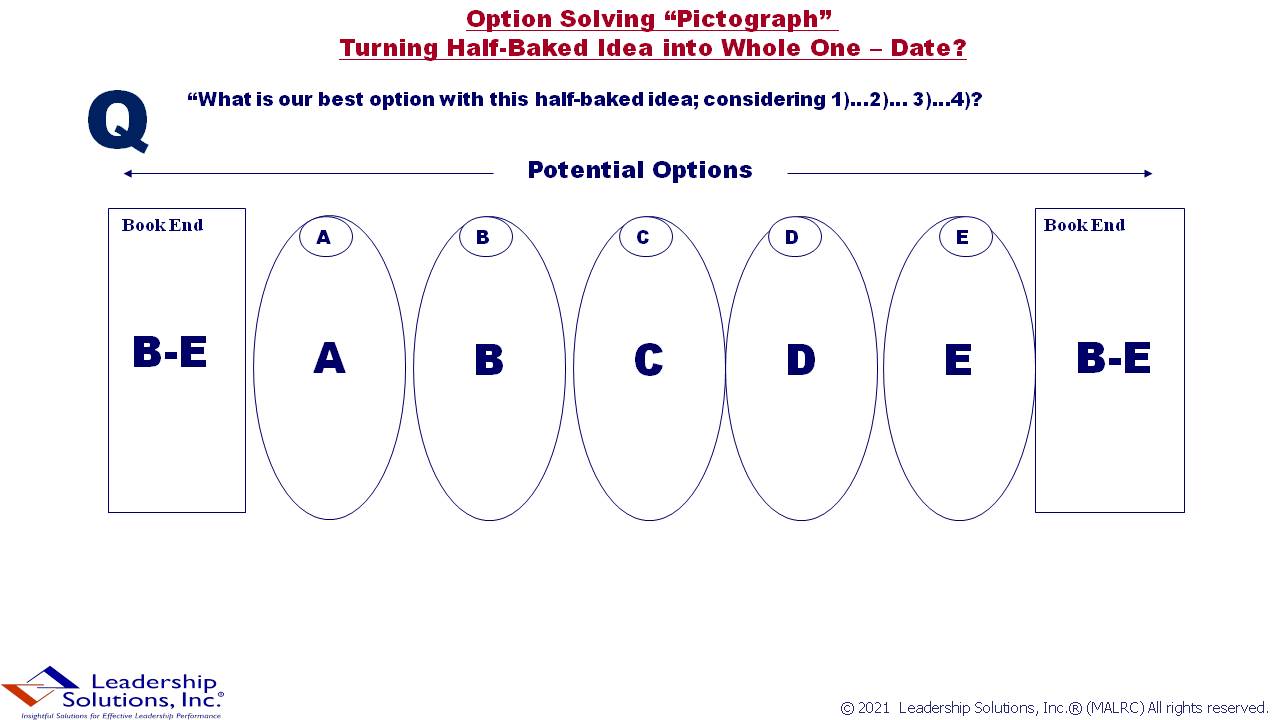by Peter A. Arthur-Smith, Leadership Solutions, Inc.®
“The pandemic, and our re-emergence from it, are reshaping the economy, government and business in lasting ways.” Wall Street Journal Exchange article ‘7 Ways Our World has Changed,’ June, 2021

As the above-mentioned article built upon the above theme, it continues: “The pandemic will undoubtedly be remembered as a similarly momentous event compared with World War I, the US’s exit from the Bretton Woods system in 1971, new Chinese leadership from late 1970s, and the great Recession of 2008 – with full repercussions that likely won’t be understood for decades.” Near term, in the Covid aftermath, it’s wreaking havoc with supply lines, associated prices, places of work, and Main Street eating and shopping. How are executive-leaders supposed to deal with all of this? We will turn to our response to the above option solving graphic shortly.
There are at least two key realities executive-leaders have to cope with: 1) They haven’t experienced anything like it before, and 2) In a fast evolving environment, they don’t have the luxury of wait and see? In a truly global economy, with instant information and where fads and fashions change overnight, they have to develop more robust ways of operating-in and dealing with uncertainty. People’s livelihoods depend on their leadership and finding an optimum way forward.
Mankind has proven its ability to adapt and survive time and again. Sometimes it has been ugly and sometimes it has coped in more elegant ways. The last time there was a pandemic in 1918: millions died, the world economy bounced back, and the Roaring-20s ensued. That catastrophe was hardly ever recalled until this pandemic arrived. Clearly organizations and businesses adapted and recovered from those times, although our questions are: How robustly and elegantly will our world economy rebound this time? Will the Roaring-20s repeat itself, even though it was eventually snuffed out by a nasty Great Depression, or will some other trauma hit world order and continue human suffering?
One thing is certain: leaders will require novel tools and mechanisms to handle a dramatic and novel set of world circumstances. Although it’s not entirely novel, since we’ve just acknowledged that it happened 100 years ago. Unfortunately, our collective memory hardly goes back that far and the relative circumstances of these two historical moments, in light of modern technologies and societal education, cannot be used as direct comparisons in terms of offering corrective solutions. Our leadership role is to make “optimum decisions” that will stabilize our organizations and their profitability, so we can move forward with confidence in an ever-evolving social and economic environment. That requires smart, agile and decisive thinking and that’s where enlightened leadership can offer its valuable decision tool called Option Solving.
Option Solving is a dramatic alternative to conventional problem solving. To start with, problem solving is somewhat of a negative concept from the outset, since problems tend to depress people – this problem, that problem, another problem. Problems often don’t have solutions conveniently attached to them. Psychologically they habitually trap people into focusing on the problem rather than potential solutions. This writer stumbled across devising option solving with a client one day, when they both became exasperated with going round and around with a typical business “problem.”
The biggest advantage of utilizing option solving is its seeming ability to tap into people’s enormous intuitive capability. This capability is so enormous that it apparently operates at about 275,000 times faster than our conventionally admired rational mind. People constantly believe they make rational decisions, when, in fact, it’s their intuitive mind that makes pretty well all their judgment calls.
Experiments have demonstrated that people’s rational minds cannot competently discern differences between black and white or truth from fiction, although their intuitive powers can draw these distinctions all the time. Our rational minds allegedly scrutinize data at 40 pieces of information per second, whereas our intuitive faculties can absorb 11 million pieces – in picture form – per second. In other words, our intuitive minds are resources that we take for granted and which we vastly underutilize because we’re so obsessed with hard data. To cater for our intuitive minds’ voracious preference for pictures, this writer turned his decision making activity into pictures – or pictographs…see initial graphic and go to www.optionsolving.com.
So returning to our opening theme of “Dealing with Uncertain Times as Economies Recover,” it’s strongly recommended that leadership teams – preferably no more than seven, including the team leader, to assist their synergistic thinking – draw upon option solving on a monthly or six-weekly basis to reassess their near-term evolving options. With a team approach, it can draw upon the “wisdom of the crowd” – potentially 77 million pieces of information per second! If your circumstances have dramatically changed with a 4-6 week period, then re-imagine your option solving pictograph. If things are roughly the same, then review your existing options in light of any fresh inputs.
The secret sauce with either pictograph: don’t spend hours agonizing over them. Your intuitive mind can absorb everything about them in split seconds. Once tweaked or re-imagined, set them aside for an appro-priate period of time to allow your enormously powerful, miniature computer-brains to consider all the permutations – known as emotional distancing. Then return as a team to your pictograph – likely focusing on other important things during the interim – for the team to make its final intuitive-decision choice.
From there it can create a corresponding action initiative – based upon WHAT, HOW, WHO, WHEN and WHERE (to obtain additional input/help) – and move forward accordingly. After a few cycles, your team will become rather fluent in this enlightened technique and make many wiser decisions as a result. Now you and your team will have head start in “dealing with uncertain times.” You will just be taking much greater advan-tage of our human capability that has heretofore been underutilized.
To learn more about envisioning and decision clarity, talk with:
